Erythrina caffra
Erythrina caffra, the coast coral tree or African coral tree, is a tree native to southeastern Africa, which is often cultivated and has introduced populations in California and India.[1][2] All the 17 species of coral tree in the genus Erythrina are collectively considered the official tree of Los Angeles, California in the United States.[3]
| Erythrina caffra | |
|---|---|
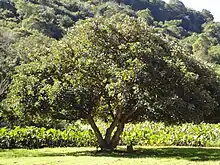 | |
| Growth habit of a mature tree | |
| Scientific classification | |
| Kingdom: | Plantae |
| Clade: | Tracheophytes |
| Clade: | Angiosperms |
| Clade: | Eudicots |
| Clade: | Rosids |
| Order: | Fabales |
| Family: | Fabaceae |
| Subfamily: | Faboideae |
| Genus: | Erythrina |
| Species: | E. caffra |
| Binomial name | |
| Erythrina caffra | |
| Erythrina caffra distribution
Extant (resident) | |
| Synonyms | |
|
Erythrina viarium Tod. | |
Description

Erythrina caffra is a medium to large deciduous tree. It grows in coastal bushes and riverine forests along the southeastern coast of South Africa and up into Zululand.
Leaves
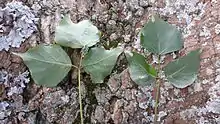
The compound leaves are made up of three leaflets. Each leaflet is broadly ovate to elliptical. The leaflets do not have prickles and are hairless.
Flowers

The flowers are made up of a main petal and four small petals. The main petal curves back to expose the stamens. The flower colour is warm red to scarlet. This is one of the main differences between Erythrina caffra and Erythrina lysistemon. The flowers form stalked axillary racemes up to 100mm long.
Trunk
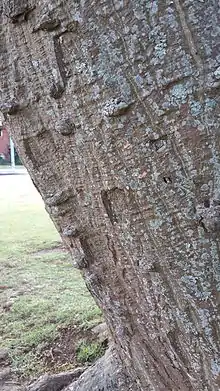
The bark on the plant or tree is relatively smooth with intermittent thorns, and the thorns tend to be sharper on younger branches.
Gallery
 Close-up view, showing leaf arrangement, shape and size
Close-up view, showing leaf arrangement, shape and size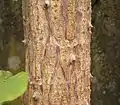 View of trunk showing prickles
View of trunk showing prickles Inflorescence
Inflorescence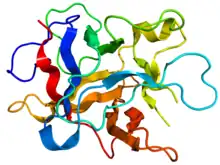 Trypsin inhibitor isolated from the seeds of Erythrina caffra
Trypsin inhibitor isolated from the seeds of Erythrina caffra
References
- "Erythrina caffra". ILDIS World Database of Legumes, version 10.01.
- Advisory Committee on Technology Innovation, Board on Science and Technology for International Development, Commission on International Relations, National Research Council (1979). Tropical Legumes: Resources for the Future. National Academy of Sciences. p. 258.
- Advisory Committee on Technology Innovation, Board on Science and Technology for International Development, Commission on International Relations, National Research Council (1979). Tropical Legumes: Resources for the Future. National Academy of Sciences. p. 258.
External links
- Werner Voigt Kirstenbosch (October 2006). "Erythrina caffra Thunb". South African National Biodiversity Institute. Archived from the original on 2012-10-06. Retrieved 2008-11-04.